Pepperdine University
Pepperdine University (/ˈpɛpərdaɪn/) is a private research university affiliated with the Churches of Christ and has its main campus near Malibu, California.[4][5] Founded by entrepreneur George Pepperdine in South Los Angeles in 1937, the school expanded to Malibu in 1972. Courses are now taught at a main Malibu campus, six graduate campuses in southern California, a center in Washington, D.C., and international campuses in Buenos Aires, Argentina; Shanghai, China; London, United Kingdom; Heidelberg, Germany; Florence, Italy; and Lausanne, Switzerland.
 | |
Former names | George Pepperdine College |
|---|---|
| Motto | Freely ye received, freely give |
| Type | Private |
| Established | 1937 |
| Affiliation | Church of Christ |
| Endowment | $887.5 million (2019)[1] |
| President | Jim Gash |
Academic staff | 393 (Full-time, 2018); 301 (Part-time, 2018) |
| Students | 7,961 (Fall 2018)[2] |
| Undergraduates | 3,627 (Fall 2018)[2] |
| Postgraduates | 4,334 (Fall 2018)[2] |
| Location | , , United States 34°02′19.26″N 118°42′27.29″W |
| Campus | Suburban 830 acres (340 ha) |
| Colors | Blue and Orange[3] |
| Athletics | NCAA Division I – WCC |
| Nickname | Waves |
| Affiliations | NAICU |
| Mascot | Willie the Wave |
| Website | pepperdine |
The university is composed of one undergraduate school (Seaver College) and four graduate schools: the Caruso School of Law, the Graduate School of Education and Psychology, the Graziadio Business School, and the School of Public Policy.
History
Early years
In February 1937, against the backdrop of the Great Depression, George Pepperdine founded a liberal arts college in the city of Los Angeles to be affiliated with the Churches of Christ and to be called—to the founder's embarrassment—George Pepperdine College.[6] On September 21, 1937, 167 new students from 22 different states and two other countries entered classes on a newly built campus on 34 acres (14 ha) at West 79th Street and South Vermont Avenue in the Vermont Knolls neighborhood of South Los Angeles,[7] later referred to as the Vermont Avenue campus.[8][9] The campus was designed in the Streamline Moderne style by John M. Cooper, an art deco architect.[10][11] By April 5, 1938, George Pepperdine College was fully accredited by the Northwest Association in large part due to the leadership of president Batsell Baxter and dean Hugh M. Tiner.[12]
The student newspaper, called the GraPhiC, published its first issue in October 1937.[13]
Pepperdine built his fortune largely through the Western Auto Supply Company, which he founded in 1909 with a $5 investment,[14] but his prosperity led to his greater ambition to discover "how humanity can be helped most with the means entrusted to [his] care. [He] considered it wrong to build up a great fortune and use it selfishly." Pepperdine voiced his twofold objective for the college that bore his name, "First, we want to provide first-class, fully accredited academic training in the liberal arts ... Secondly, we are especially dedicated to a greater goal—that of building in the student a Christ-like life, a love for the church, and a passion for the souls of mankind."[15]
The college expanded significantly in the years following its founding, reaching an enrollment of 1,839 for the 1948–1949 year.[16] The college's first graduate program, a master of arts in religion, admitted its first students in 1944,[17] and the school's first international program, a year-long program in Heidelberg, Germany, was launched in 1963.[18]
Move to Malibu
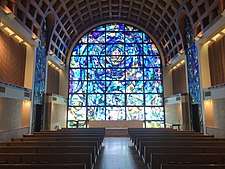
By 1957, when Norvel Young was named president, the young college faced serious problems, not least of which was the high cost of expansion in South Los Angeles.[19] The area around the Vermont Avenue campus was developing issues including rising crime and urban decay, and racial tensions had arisen that led to the 1965 Watts Riots.[20] In December 1970, student activists threatened to burn down the campus, even setting small fires in three buildings.[21] They later occupied the Academic Life building, leading to a standoff with the Los Angeles Police Department that was defused by negotiations with vice president William S. Banowsky.[22]
Before the worst of the tensions began, President Young had already begun to look for suburban sites to expand the university's footprint.[19] In 1966, a committee was formed to look at potential locations, including sites in Westlake Village and Calabasas.[9][19] Pepperdine favored the Westlake Village location until the Adamson-Rindge family, who owned hundreds of acres near Malibu, offered to donate 138 acres (56 ha) and to sell 58.7 adjacent acres. Despite concerns over building costs on the mountainous site, the school decided to move forward based on its prime location and potential for raising donations, accepting the land in Malibu in 1968.[9][23] Construction began on April 13, 1971 and the new campus opened for student enrollment in September 1972.[9][24] The campus and many of its buildings were planned by Los Angeles–based architect and urban planner William Pereira, who had also designed the Los Angeles County Museum of Art and much of the University of Southern California.[25] The construction of the Malibu campus was made possible largely by gifts from Blanche Seaver, the wife of Frank R. Seaver and heir of his oil-drill manufacturing fortune, who donated to Pepperdine more than $160 million over her lifetime.[26] The undergraduate college was officially named after Seaver in 1975.[27]
The university retained and continued to expand its original Vermont Avenue campus, building a new academic building there in 1970, and redesigning the curriculum to serve its more urban setting.[28] Much of the undergraduate liberal arts program, however, moved to the new Malibu campus.[29] In the decade to come, the Vermont Avenue campus transitioned away from its residential model, and in 1981 the Vermont Avenue campus was sold to Crenshaw Christian Center, whose minister, Frederick K.C. Price, then oversaw construction of the "faith dome," then the largest-domed church in the United States.[30]
Growth of the university
| Presidents of Pepperdine | |
|---|---|
| President | |
| Batsell Baxter | |
| Hugh M. Tiner | |
| M. Norvel Young | |
| William S. Banowsky | |
| Howard A. White | |
| David Davenport | |
| Andrew K. Benton | |
| James A. Gash | |
Just as the university was looking for room to expand, it established several graduate schools. In 1969, Pepperdine bought the Orange University College of Law in Santa Ana, California, which became the School of Law and moved to the Malibu campus in 1978.[31] What had been a business division offering graduate and undergraduate degrees became a graduate business school in 1968, which in 1971 was named the School of Business and Management and is now the Graziadio Business School.[32] Also in 1971, the School of Education was formed, which in 1981 became the Graduate School of Education and Psychology.[33] Pepperdine administrators used these expansions as justification to change the institution's name to Pepperdine University in 1971.[34]
Pepperdine continued to expand, adding permanent international programs in London[35] and in Florence[36] beginning in 1984 and 1985, respectively. These were followed by similar programs in Buenos Aires, Lausanne, and Shanghai. The Malibu campus itself was expanded by the construction of the 50.4 acres (20.4 ha) Drescher Graduate Campus, which was completed in 2003 under the supervision of president Andrew K. Benton.
Brushfires

Pepperdine's Malibu campus has often been threatened by brushfires, including in 1985, 1993, 1996, 2007, 2007, and 2018. The university prepares for the fires by clearing brush 200 feet from all buildings and has developed plans with Los Angeles County Fire Department to shelter faculty, staff, and students in place.[37][38]
Campus
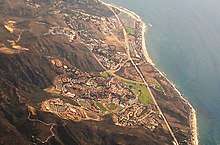
_(3124893785).jpg)

Malibu campus
Pepperdine's Malibu campus is situated on 830 acres (340 ha) of the Santa Monica Mountains overlooking the Pacific Ocean and the Pacific Coast Highway in Malibu, California.[39] It is widely considered one of the most beautiful college campuses in the world in terms of scenery and architecture, and has been described as "a place that looks more like a beach resort than a private university."[40] The campus offers views of the Santa Monica Bay, Catalina Island, the Palos Verdes Peninsula, and much of the westside of Los Angeles. Most buildings are designed in the Mediterranean Revival Style with white stucco walls, red tile roofs, and large tinted windows. The first round of construction on the site was completed in 1973.
The most distinctive feature of the Malibu campus, apart from its location, is the Phillips Theme Tower, a 125-foot obelisk with an embedded cross that stands on the front lawn. The tower was designed by William Pereira in 1972, and construction was completed in 1973.[41] The tower was dedicated in 1974 as a symbol of Pepperdine's dedication to its Christian mission. Following disputes with Malibu residents over the lighting of the cross, the tower has not been illuminated since 1980.[42]
Alumni Park is located on the lowest part of the Malibu campus, adjacent to the Pacific Coast Highway. It is a 30-acre expanse of lawns, trails, hills, ponds and coral trees overlooking the Pacific Ocean.[43] Landscape architects Eric Armstrong and S. Lee Scharfman were responsible for the campus green space planning and design.[25] The park was dedicated in 1979, and it now serves as the location for the university's commencement exercises.[39] Overlooking Alumni Park is Stauffer Chapel, with its 3,000 square feet of stained-glass windows designed by Robert and Bette Donovan and constructed in 1973.[42]
The main academic plaza for the undergraduate programs of Seaver College lies on a knoll above Alumni Park and includes Tyler Campus Center, Payson Library, and the Weisman Museum of Art. Undergraduate housing and athletic facilities sit to the northwest of the academic complex. The School of Law is situated on a hill above these areas. Banowsky Boulevard separates Alumni Park from the main academic complex and is named in honor of William S. Banowsky, the fourth president of Pepperdine. Spur roads to the east lead to faculty housing.
The Drescher Graduate Campus is contiguous with and northwest of the central campus. Construction was completed in 2003, and it is now home to the School of Public Policy, the Villa Graziadio Executive Center, and the full-time programs of the Graziadio Business School and the Graduate School of Education and Psychology, as well as housing for students and faculty.[44]
Graduate campuses
The Graziadio Business School and the Graduate School of Education and Psychology are headquartered in West Los Angeles at the Howard Hughes Center next to Interstate 405. These two schools also offer programs at graduate campuses in West Los Angeles, Encino, Irvine, and Calabasas.
International campuses
Pepperdine owns and operates permanent satellite campuses in six countries, with each campus offering semester- and year-long programs for students of Seaver College. The first such program was opened in 1963 in Heidelberg. Programs were then introduced in the South Kensington district of London in 1984 and in Florence in 1985.[45] Since then, programs have been launched in Buenos Aires, Lausanne, and Shanghai. The School of Law also offers regular programs at the campus in London. In addition to these regular offerings, international programs of the university's various schools have also taken place in Paris, Madrid, Johannesburg, Tegucigalpa, Brisbane, Chiang Mai, Hong Kong, and Tokyo.
Academics
Frank R. Seaver College of Letters, Arts, and Sciences
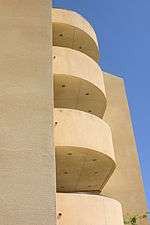
Seaver College is named for Frank R. Seaver and his wife Blanche, the principal benefactors of Pepperdine's Malibu campus. The college offers undergraduates a liberal arts education; each candidate for a bachelor's degree must complete a broad program of general education courses.[46] Seaver's general education requirements have received an A rating from ACTA's annual What Will They Learn report for several years running.[47] Seaver students attend classes at the Malibu campus, and most students study abroad either at one of the University's permanent international campuses in Buenos Aires, Florence, Heidelberg, Lausanne, London, and Shanghai or at one of several summer programs.[46][48] The current dean is Michael Feltner.[46][49]
Seaver College offers 42 majors and 40 minors across eight academic divisions: business administration, communication, fine arts, humanities and teacher education, international studies and languages, natural science, religion and philosophy, and social science.[46]
In addition to bachelor's degrees, the college offers the following graduate degrees: Master of Arts in American studies, Master of Arts in Religion, Master of Science in Ministry, Master of Divinity, and Master of Fine Arts in Screen and Television Writing. Seaver students can also earn both single-subject and multiple-subject teaching credentials.[46]
The Religion Division offers undergraduate and graduate education in ministry, administers a Center for Faith and Learning and an Office of Church Relations, and publishes Leaven: A Journal of Christian Ministry.[50]
Graziadio Business School
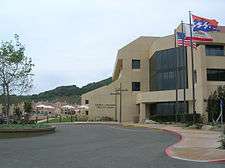
Pepperdine University's Graziadio Business School enrolls approximately 2,000 students in its full-time and part-time degree programs. The school was founded in 1969, and has since graduated over 30,000 alumni. Deryck J. van Rensburg has served as dean since 2014. In 2016, U.S. News & World Report ranked the online MBA program tied for 15th best in the country, and the part-time MBA program was ranked at 29th nationally.[51] In 2016, U.S. News & World Report ranked Pepperdine overall 65th out of 437 business programs in the United States.[52]
School of Law
The School of Law is located on the Malibu campus adjacent to Seaver College, and enrolls about 600 students.[53] It is fully accredited by the American Bar Association, is a member of the Association of American Law Schools, and hosts a chapter of the Order of the Coif.[54][55] The School's Straus Institute of Dispute Resolution is consistently ranked as a leading dispute resolution program,[51] offering Master's and Certificate programs. Other degree programs include the Juris Doctor/Master of Divinity with Seaver College, the JD/MBA, JD/MPP, and JD/MDR.[53] The school offers both a summer session and a fall semester at the university's campus in London. The current dean is Paul L. Caron, and Deanell Reece Tacha is the dean emeritus.[53]
The school is ranked 47th[56] among the nation's "Top 100" law schools by the 2021 U.S. News & World Report rankings.[51] It is known for its entertainment law program.[57]
Graduate School of Education and Psychology
The Graduate School of Education and Psychology (GSEP) offers both masters and doctorate programs, including EdD, PsyD, and PhD degrees.[58] Student enrollment is about 1,600.[58] Its programs are accredited by WASC and the APA.[58] The current dean is Helen Easterling Williams.[58]
School of Public Policy
The School of Public Policy enrolls approximately 70 graduate students in its two-year master's degree in public policy (MPP).[59]
Joint degree programs include the following:
- MPP/Juris Doctor with the Law School.
- MPP/Masters of Dispute Resolution with the Law School's highly rated Straus Institute for Dispute Resolution.[60]
- MPP/MBA degree with the Graziadio Business School.
Notable faculty at the school include Ted McAllister, James Q. Wilson, James Prieger (Senior Economic Advisor, FCC), Joel Fox, Angela Hawken, Gordon Lloyd and Robert Kaufman.
Notable graduates include a former member of the Bush Administration: Eryn Witcher, Director of Television.[61]
The current dean of the school is Pete Peterson.[62]
Student body
| Ethnic enrollment, Fall 2018[2] |
Under- graduates |
|---|---|
| African American | 176 (4.8%) |
| Native American | 13 (0.4%) |
| Asian American and Pacific Islander |
376 (10.3%) |
| Hispanic and Latino American |
494 (13.6%) |
| White | 1,781 (49.1%) |
| Two or more races | 235 (6.5%) |
| International | 466 (12.8%) |
| Unknown | 86 (2.4%) |
| Total | 3,627 (100%) |
Pepperdine's Fall 2018 enrollment was 7,961 students, of whom 3,627 are at the undergraduate and 4,334 at the graduate and professional levels.[2]
In the 2017 academic year, the freshman retention rate was 91%.[2]
| 2018 | 2017 | 2016 | 2015 | 2014 | |
|---|---|---|---|---|---|
| Applicants | 12,134 | 11,704 | 11,111 | 9,923 | 8,914 |
| Admits | 4,249 | 4,664 | 4,097 | 3,781 | 3,161 |
| % Admitted | 35.0 | 39.8 | 36.9 | 38.1 | 35.5 |
| Enrolled | 803 | 862 | 743 | 745 | 655 |
| Average GPA | 3.66 | 3.64 | 3.64 | 3.59 | 3.61 |
| ACT Range | 26–32 | 26–31 | 26–31 | 25–30 | 25–30 |
| SAT Range* | 1700–2020 | 1670–2020 | 1660–1980 | 1650–1970 | 1680–1990 |
| * SAT out of 2400 |
Admissions
13,721 students applied for admission to the undergraduate class of 2023, and 4,241 were admitted (30%); Among admitted freshmen, the interquartile ranges for SAT composite scores, ACT composite scores, and unweighted GPAs were 1300–1450, 28-32, and 3.64–3.97, respectively.[64]
Admission to Pepperdine is rated as "more selective" by U.S. News & World Report[51] and by the Carnegie Classification of Institutions of Higher Education.[65]
Yellow Ribbon Program for Veterans
Pepperdine University is part of the Yellow Ribbon Program for Veterans. Like several other colleges and universities that participate in the program, Pepperdine University offers support for an unlimited number of veteran students as well as an unlimited monetary contribution toward each veteran's tuition assistance.[66] As of 2016, 72% of Pepperdine students who are veterans are in the Yellow Ribbon Program which enables Veterans to attend tuition-free.[67]
Rankings and reputation
| University rankings | |
|---|---|
| National | |
| Forbes[68] | 129 |
| THE/WSJ[69] | 137 |
| U.S. News & World Report[70] | 50 |
| Washington Monthly[71] | 203 |
U.S. News & World Report ranked Pepperdine tied for the 50th best national university, tied for 20th in undergraduate teaching, and tied for 24th best college for veterans in its rankings for 2020.[72] Pepperdine was ranked number 1 in the Institute of International Education's 2015 Open Doors Report, with 86.5 percent of all undergraduate students studying abroad during the 2013–2014 academic year.[73]
The School of Law placed 47th among the nation's "Top 100" law schools by the 2021 U.S. News & World Report rankings.[51] It is known for its entertainment law,[57] and also its dispute resolution program, which is currently ranked No. 2 in the nation.[51] In 2018, U.S. News & World Report ranked Pepperdine's business school 65th out of 437 business programs in the United States.[52] Forbes magazine has ranked the Graziadio School's Fully Employed MBA programs in the world's Top 20 based on ROI.
In 2019, the American Council of Trustees and Alumni included Pepperdine in its What Will They Learn? study, which is an annual evaluation system of colleges and universities. The report assigns a letter grade to 1,120 universities based on how many of the following seven core subjects are required: composition, literature, foreign language, American history, economics, mathematics and science. Pepperdine was one of 23 schools to receive an "A" grade, which is assigned to schools that include at least six of the seven designated subjects in their core curriculum.[47]
Athletics
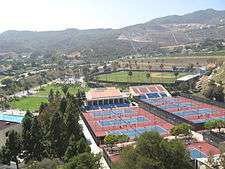
Pepperdine University competes in NCAA Division I intercollegiate athletics. Most teams play in the West Coast Conference, but men's volleyball plays in the Mountain Pacific Sports Federation and men's water polo plays in the Golden Coast Conference. Pepperdine's teams are known as the Waves.
Pepperdine University is often ranked by the NACDA Director's Cup as having one of the most successful athletic programs for non-football Division I schools, ranking first on three occasions (most recently in 2011–12) and finishing in the top three eight times in the last fifteen years.[74] Pepperdine University sponsors seventeen NCAA Division I intercollegiate athletics teams: baseball, basketball, cross country, golf, tennis, track, volleyball, and water polo teams for men; and basketball, cross country, golf, soccer, swimming and diving, tennis, track, indoor volleyball, and beach volleyball for women.[75] There are also several intercollegiate sports clubs such as women's lacrosse, surfing, and men's rugby.[76]
NCAA Division I team championships:
- Baseball (1992)
- Men's golf (1997)
- Men's tennis (2006)
- Men's volleyball (1978, 1985, 1986, 1992, 2005)
- Water polo (1997)
NCAA Division I individual titles:
- Robbie Weiss (1988 tennis – singles)
- Carlos Di Laura & Kelly Jones (1985 tennis – doubles)
- Jerome Jones & Kelly Jones (1984 tennis – doubles)
Notable people
There are currently over 100,000 living alumni worldwide.[77] Notable alumni of Pepperdine University include prominent scientists, musicians, businessmen and women, engineers, architects, athletes, actors, politicians, and those who have gained both national and international success. The Pepperdine alumni network consists of over 30 alumni groups on four continents.[78]
- Notable Pepperdine University alumni include:
 Sarah Attar, first female Saudi Arabian Olympian
Sarah Attar, first female Saudi Arabian Olympian- Chace Crawford, actor
- Sharon Draper, children's writer and a professional educator
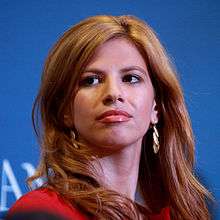 Michelle Fields, political journalist
Michelle Fields, political journalist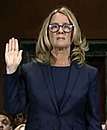 Christine Blasey Ford, American professor
Christine Blasey Ford, American professor Colleen Graffy, former United States Deputy Assistant Secretary of State for Public Diplomacy
Colleen Graffy, former United States Deputy Assistant Secretary of State for Public Diplomacy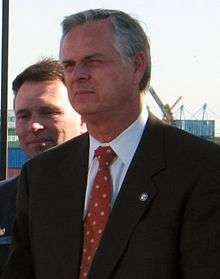 James Hahn, former mayor of Los Angeles
James Hahn, former mayor of Los Angeles.jpg) Dan Haren, former professional baseball pitcher
Dan Haren, former professional baseball pitcher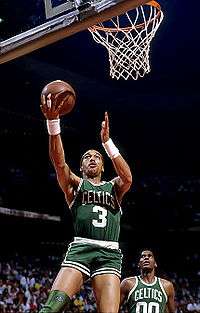 Dennis Johnson, Hall of Fame basketball player
Dennis Johnson, Hall of Fame basketball player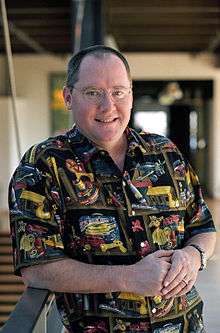
- Mike Leach, American college football coach
.jpg) Oscar Munoz, president and CEO of United Airlines
Oscar Munoz, president and CEO of United Airlines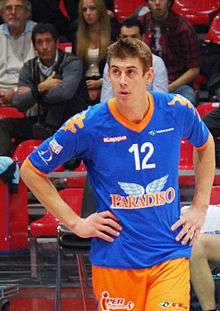 Sean Rooney, Olympic gold medalist volleyball player
Sean Rooney, Olympic gold medalist volleyball player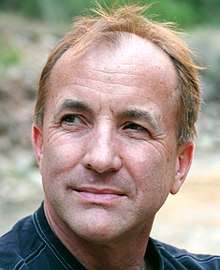 Michael Shermer, science writer, historian of science, founder of The Skeptics Society
Michael Shermer, science writer, historian of science, founder of The Skeptics Society Tahj Mowry, American Actor and brother of Tia Mowry and Tamera Mowry. Most notable for his commercials, appearances on Full House, and Smart Guy.
Tahj Mowry, American Actor and brother of Tia Mowry and Tamera Mowry. Most notable for his commercials, appearances on Full House, and Smart Guy.
In popular culture
- Battle of the Network Stars (1976–1988; 2017)[79][80] and Zoey 101 (2005–2008)[81] were filmed on the campus.
- The water polo competitions for the 1984 Summer Olympics were held at Raleigh Runnels Memorial Pool on campus.[82]
References
- As of June 30, 2019. "U.S. and Canadian 2019 NTSE Participating Institutions Listed by Fiscal Year 2019 Endowment Market Value, and Percentage Change in Market Value from FY18 to FY19 (Revised)". National Association of College and University Business Officers and TIAA. Retrieved April 22, 2020.
- "Pepperdine University Common Data Set 2018-2019" (PDF). Pepperdine University. Retrieved August 1, 2019.
- "Official Colors | Resources | Pepperdine Community". Community.pepperdine.edu. Retrieved April 5, 2016.
- "American FactFinder". Factfinder.census.gov. Retrieved March 8, 2014.
- "Malibu Campus – Seaver College" (PDF). Pepperdine University. Retrieved October 27, 2011.
- Baird 2016, p. 19–20.
- Collier, Aldore (December 1989). "FaithDome: A grand-slam homer for Jesus. - Ebony".
- Jahn, Vanessa (Spring 2006). "GSEP 35th Anniversary: A Celebratory Evening to Remember". Colleague Alumni Magazine. Archived from the original on May 4, 2008.
- Domingo, Tracy (November 14, 2002). "Miracle at Malibu Materialized". Graphic.pepperdine.edu. Archived from the original on January 9, 2013.
- Baird 2016, p. 20.
- "Pepperdine College". January 4, 2012.
- Baird 2016, p. 29.
- Baird 2016, p. 26.
- Baird 2016, p. 4–5.
- Dochuk, Darren. "From Bible Belt to Sunbelt: plain-folk religion, grassroots politics, and the rise of evangelical conservatism". pp. 51–52.
- Baird 2016, p. 49.
- Baird 2016, p. 39.
- Baird 2016, p. 146.
- Baird 2016, p. 267.
- Baird 2016, p. 160.
- Baird 2016, p. 170.
- Baird 2016, p. 170–171.
- Baird 2016, p. 277.
- Baird 2016, p. 295, 305.
- "Pepperdine University | Los Angeles Conservancy". Laconservancy.org. Retrieved March 8, 2014.
- Baird 2016, p. 283.
- Baird 2016, p. 299.
- Baird 2016, p. 178–179.
- Baird 2016, p. 179.
- Baird 2016, p. 193–194.
- Baird 2016, p. 247–252.
- Baird 2016, p. 211.
- Baird 2016, p. 231, 241.
- Baird 2016, p. 199.
- Baird 2016, p. 258.
- Baird 2016, p. 441.
- Mejia, Brittny (November 14, 2018). "Pepperdine University defends 'shelter in place' decision during Woolsey fire". Los Angeles Times. Retrieved July 22, 2019.
- Hong, Joseph (November 12, 2019). "Pepperdine University responds to criticism regarding 'shelter in-place' Woosley Fire policy". Desert Sun. Retrieved July 22, 2019.
- Baird 2016, p. 459.
- "15 of the Most Beautiful College Campuses". Expedia.com. Retrieved January 8, 2018.
- Baird 2016, p. 296.
- Baird 2016, p. 297.
- "Alumni Park". pepperdine.edu. Retrieved June 24, 2018.
- Baird 2016, p. 445.
- Baird 2016, p. 258, 441.
- "Seaver College of Letters, Arts, and Sciences 2019–2020 Academic Catalog" (PDF). Pepperdine University. Retrieved July 30, 2019.
- "What Will They Learn 2018–2019: A Survey of Core Requirements at Our Nation's Colleges and Universities" (PDF). American Council of Trustees and Alumni. Retrieved July 31, 2019.
- "Learn about life abroad at the Return". Pepperdine University Graphic. Retrieved July 30, 2019.
- "Meet the Deans and Directors". Pepperdine University. Retrieved April 20, 2015.
- "Religion Division | Seaver College | Pepperdine University". Seaver.pepperdine.edu. Archived from the original on March 3, 2014. Retrieved March 8, 2014.
- "U.S. News Best Colleges Rankings - Pepperdine University". U.S. News & World Report. Retrieved February 14, 2016.https://www.usnews.com/best-graduate-schools/top-law-schools/pepperdine-university-03011
- "US News Rankings". Grad-schools.usnews.rankingsandreviews.com. Archived from the original on September 14, 2010. Retrieved April 23, 2016.
- "Pepperdine School of Law Catalog 2018–2019" (PDF). Pepperdine University School of Law. Retrieved July 31, 2019.
- "News | School of Law | Pepperdine University". Law.pepperdine.edu. December 6, 2013. Archived from the original on August 3, 2008. Retrieved March 8, 2014.
- Anesha Smith. "member chart". Orderofthecoif.org. Archived from the original on March 27, 2014. Retrieved March 8, 2014.
- "Pepperdine Caruso School of Law Ranked 47 in U.S. News and World Report 2021 Best Law Schools Ranking - Surf Report | Pepperdine Caruso School of Law". law.pepperdine.edu. Retrieved March 30, 2020.
- "Best Entertainment Law Schools and Sports Law Schools". Top-law-schools.com. Retrieved March 8, 2014.
- "Graduate School of Education and Psychology 2018–2019 Academic Catalog" (PDF). Pepperdine Graduate School of Education and Psychology. Retrieved July 31, 2019.
- "Pepperdine School of Public Policy 2018–2019 Academic Catalog" (PDF). Pepperdine School of Public Policy. Retrieved July 31, 2019.
- "Best Dispute Resolution Programs | Top Law Schools | US News Best Graduate Schools". Grad-schools.usnews.rankingsandreviews.com. Archived from the original on January 1, 2011. Retrieved December 27, 2011.
- Pepperdine University – School of Public Policy Celebrates 2006 Graduation Archived September 8, 2006, at the Wayback Machine
- Giacobbe, Katie. "Pete Peterson Named Dean of Pepperdine School of Public Policy". Malibu Times. The Malibu Times. Retrieved April 24, 2016.
- "Seaver College Admission Fast Facts". Pepperdine University. Retrieved August 19, 2019.
- "Fall 2019 First-Year Profile". Pepperdine University. Retrieved August 19, 2019.
- "Pepperdine University". The Carnegie Classification of Institutions of Higher Education. Retrieved August 1, 2019.
- "Yellow Ribbon Program - Education and Training". www.benefits.va.gov. 2016. Retrieved June 14, 2016.
- "Yellow Ribbon Program at Pepperdine | Office of the University Registrar | Pepperdine University". www.pepperdine.edu. 2016. Retrieved June 14, 2016.
- "America's Top Colleges 2019". Forbes. Retrieved August 15, 2019.
- "U.S. College Rankings 2020". Wall Street Journal/Times Higher Education. Retrieved September 26, 2019.
- "Best Colleges 2020: National University Rankings". U.S. News & World Report. Retrieved September 8, 2019.
- "2019 National University Rankings". Washington Monthly. Retrieved August 20, 2019.
- "Pepperdine University Rankings". U.S. News & World Report. Retrieved September 9, 2019.
- "Pepperdine Ranks No. 1 in the Institute of International Education's 2015 Open Doors Report | Pepperdine Newsroom". newsroom.pepperdine.edu. Archived from the original on November 28, 2015. Retrieved November 1, 2016.
- "Pepperdine Athletic Traditions". Pepperdine Waves. Retrieved July 31, 2019.
- "Pepperdine Waves". Pepperdine Waves. Retrieved July 31, 2019.
- "Club Sports". Pepperdine University. Retrieved July 31, 2019.
- "Welcome | Alumni Association | Pepperdine University". Pepperdine.edu. Retrieved January 19, 2019.
- "Under Construction | Chapters | Alumni Association | Pepperdine University". Pepperdine.edu. Retrieved March 8, 2014.
- Baird 2016, p. 366.
- "Battle of the Network Stars". Retroland. Retrieved April 5, 2016.
- "The Graphic - What Pepperdine learned in 'Zoey 101'". Graphic.pepperdine.edu. August 30, 2004. Retrieved February 24, 2016.
- "Official Report of the Games of the XXIIIrd Olympiad, Los Angeles, 1984". LA84 Foundation. Retrieved August 1, 2019.
Further reading
Baird, David (2016). Quest for distinction : Pepperdine University in the 20th century. Malibu, California: Pepperdine University Press. ISBN 9780997700404.CS1 maint: ref=harv (link)
External links
| Wikimedia Commons has media related to Pepperdine University. |
- Official website
- Pepperdine University Athletics website
- Image of Black students protesting the college's decision to not renew the contract of African American public relations writer, Ron Ellerbe, 1970s. Los Angeles Times Photographic Archive (Collection 1429). UCLA Library Special Collections, Charles E. Young Research Library, University of California, Los Angeles.